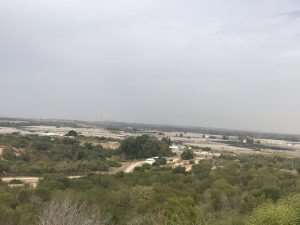
The state of Israel has over the past seventy years, strived to create value in different sectors of their economy through extensive research and development.
Israel, noted for its impressive military technology, a robust startup space, as well as medical and scientific breakthroughs, has also gradually become one of the world's leaders in water, irrigation and agricultural technology.
Israel currently produces 95% of its food requirements, though only less than 4% of the population is into agriculture.
Israel is located between 29°-33° north of the equator, which is characterized as a subtropical region, between the temperate zone and the tropical zone. The northern and coastal regions of Israel show Mediterranean climate characterized by hot and dry summers and cool rainy winters. Whereas the southern and eastern areas of Israel are characterized by an arid climate.
The rainy season extends from October to early May, and rainfall peaks in December through February. Rainfall varies considerably by regions from the North to the South. Highest rainfall is observed in the North and center parts of the country and decreases in the southern part of Israel, from the Negev Desert to Eilat where rainfall is negligible.

Agriculture in Israel
However, the nation of Israel, through consistent research, has managed to become a global leader in agricultural technology.
An estimated 80% of waste water in Israel is recycled for use in agriculture.
By employing climate-smart technologies, farms are able to produce more food per acre with very little input, and with very little or no waste in some cases.
Israel has produced resilient seeds, top-notch post-harvest technology and an agribusiness industry that ensures total value for money.
Some interesting numbers – Israel and Ghana
Comparatively, Israel is just about the size of the Ashanti region, about 2000 square kilometers short of the most populous region in Ghana.
Whereas over 80% of the land in the Ashanti Region is arable, only about 20% of the land in Israel is arable, with relatively lower rainfall and water resources.
The structure of the Ashanti economy is closely linked to the abundance of natural resources found in the region, providing a comparative advantage in resource extraction and processing.
The value created by the Ashanti economy could be ten times that created by the Israeli economy. However, like the whole of Ghana, the region has consistently failed to grow and be a powerhouse of production.

Israel is a world leader in water recycling
Israel is a country that has almost nothing but manages produces almost everything they need.
There are a lot of lessons to be learned from countries like Israel if Ghana is really serious about being less dependent on imports and aid.
Ghana needs to invest in research and development. The Council for Scientific and Industrial research must be resources to scale their work. More work needs to be done to developed better seeds and inputs for agriculture.
The fertilizer subsidy programme must be revisited. An updated database of the soil types and compositions across the country must be prepared to improve the efficiency of the programme. The wholesale application of the same types of fertilizers across the country without a proper analysis of the nutrient needs of soils and crops is inefficient and must be reviewed.
Community-based recycling initiatives must be employed countrywide to catalyze irrigation and organic fertilizer production. The Ghana Irrigation Authority, the Industrial Research Institute, Community Water and Sanitation Agency and related institutions should collaborate with appropriate institutions, both in the public and private sectors, to achieve this. The 1 district 1 dam initiative is laudable but could be improved by incorporating recycling and reuse of waste water in the country.
Ghana is spending GHS3,335,031,070, the equivalent of USD 723,538,502 over a four year period on the planting for food and jobs (PFJ) program.
A critical look at the program shows very little research and development (truth is, there is no allocation for research and development). The program is basically one of the many procurement activities we employ as a country to deal with our long-term problems.
Beyond the current 4-year PFJ, how does GHANA intend to sustain food production and improve food security?
Can we continue along this path?
Who is thinking for Ghana?
Ghana has the capacity to feed West Africa. It is up to us to be smart and survive, or be slow and whither in the face of global competition.
–
By: Kojo Akoto Boateng/citinewsroom.com/Ghana




 4,300 Liberians at Buduburam Refugee Camp to return home
4,300 Liberians at Buduburam Refugee Camp to return home
 Two dead in premix fuel depot explosion at Essikado-Ketan
Two dead in premix fuel depot explosion at Essikado-Ketan
 Driver of President Akufo-Addo convoy SUV dies in road crash
Driver of President Akufo-Addo convoy SUV dies in road crash
 Akufo-Addo's convoy in fatal crash
Akufo-Addo's convoy in fatal crash
 Mepe flood victims still in tents 8months after Akosombo Dam spillage
Mepe flood victims still in tents 8months after Akosombo Dam spillage
 Kpemka’s appointment as Deputy BOST MD is unconstitutional – Kwabena Donkor
Kpemka’s appointment as Deputy BOST MD is unconstitutional – Kwabena Donkor
 Voter registration: Two Togolese Nationals arrested in Buem for attempting to re...
Voter registration: Two Togolese Nationals arrested in Buem for attempting to re...
 DR Congo thwarts Kinshasa 'coup attempt': army
DR Congo thwarts Kinshasa 'coup attempt': army
 Media has made good progress in Ghana — Frema Opare
Media has made good progress in Ghana — Frema Opare
 Election 2024: NDC pledges to scrap betting tax, targets 80% youth support
Election 2024: NDC pledges to scrap betting tax, targets 80% youth support
